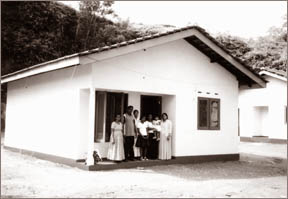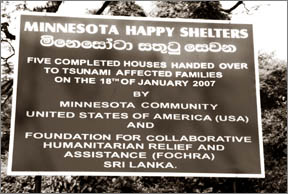|
observer |
|
|
|
|
|
OTHER LINKS |

|

|

|
From Minnesota with loveThis story perhaps reevaluates the life of a fisher family of Kalutara, Sri Lanka, two years after the destructive Asian tsunami struck. It also espys the fisher folk of Kalutara and its environs.
Kalutara is just 28 miles south of the island's capital, Colombo, on its western coast. This part of the country's seaboard was shielded by its eastern and southern coasts, which took the brunt of the devastating waves, that critical Boxing Day. Thus, in this study, we can touch more on post-tsunami assistance and adaption following the tsunami, than dwell on loss of life and limb, which had perhaps been adequately featured. The head of the family, M Raju Bernard Cooray, now, 42, worked for a mudalali or small-time entrepreneur called Marcus, going out to sea in a 34 foot multiday boat, named Prisca. (Prisca was completely destroyed). Their crew of five stayed at sea, up to 20 days, and if they returned with a good catch, the most this middle aged man could take home was 10,000 rupees or the equivalent of $100. But, sometimes, there was no fish to catch, for, coastal over-fishing and dynamiting of fish resources, had and more so, now, leaves coastal fisheries resources fast dwindling.
They must also catch fish in the lower levels of the ocean, which resources go untapped. The same has been said about India, for instance. But, little has been done in these respects in such Third World Indian Ocean nations, and beyond, due to the lack of funds, know-how and political will. But, on the southern and western coasts, and close to Kalutara, is the Beruwela fisheries harbour, which was completed a few years ago. These fisheries harbours were and are being built, to accommodate the island's increasing number of multiday boats, which before the tsunami counted 1,800. Even before the tsunami, this fisher family, like others of the fisher clan, of their village, and around the island, lived on credit, obtaining their consumer necessities from grocery stores and paying back with interest, in better times. Like all fisher families, from the dawn of time the fisher village in Kalutara lived in close proximity to the sea; the Cooray family lived 35 metres from where land separates the waves. Their house, in Katukurunda, was a big one, with two rooms, dining room and kitchen, and toilet facilities, which most fisher families in Sri Lanka lack. The house was built 23 years before the tsunami struck, on seven perches of land, which Cooray's wife, S H Rohini Silva obtained from her uncle, in turn, being a government grant. All of the family escaped death, but not injury. Daughter M Thilini Lakshani Cooray, now 18, was four months with child. Her husband, D Sanjay Ruksha 21, rescued her and their daughter is one-and-a-half-years old. The other members of the family are sons, Rasika Dilan Cooray, 23, also married, and has a daughter four years old. Son, Niranjan Pradeep Cooray 20, is a bachelor and goes to sea with another entrepreneur, while in past decades, fishing was a family enterprise. Another daughter, Dilini Rukshani Cooray 16 attends school. Dilini, an average student, knew not what her future would be, or where she would find employment. With little money in the family kitty, of fisher folk, the possibilities are that school leavers end up in early marriage. This norm of early marriage among families who by and large live by their parent's occupation, be they fishers, cinnamon peelers or estate workers, while finding partners from among their clan, continues today. But, it deviates from other folk who aspire for jobs, through education and the acquisition of skills. Some members of such families which pursue the occupation of their parents and the instances being more among females, find partners from outside their parent's occupation. In this instance, Thilini and her husband Rukshan have ventured to Polonnaruwa, where Rukshan buys garments from wholesalers and sells it in the village fair. But, with business being dull, they were temporarily, with the rest of their family, at Dipowatte, where the tsunami refugees from Kalutara are housed. Dipowatte is a sprinkling of temporary timber houses, two kilometres from the sea. The authorities are discouraging these refugees from continuing to live here, and have cut off electricity supply. Dipowatte, is unclean and infested with rats. The head of the family, Bernard Cooray, now works for a lady entrepreneur Ranjani, who owns a multiday boat. Ranjani, has another multiday boat, both anchored nine kilometres away at the Beruwela fisheries harbour. Bernard Cooray and his extended family are now proud owners of this tiled house, in Goonetillake Watte, Nagoda, Kalutara, three kilometres from the sea shore, along with four other families. It is a gift from the Minnesota Community, of USA. The land is a gift from the government, and each recipient gets eight perches. Each house costs $6000, and counts two rooms, a living room, kitchen and toilet, with room for expansion. Another $7,000 would be needed to provide electricity, water, drainage and other essential infrastructure facilities. The Minnesota Community earlier planned to build 20 houses, but costs escalated. The project will continue with funds from the USA coming in, until the 20 houses are built. Originally, the Minnesota Community planned to repair 30 houses and build 20 more in a village in Moratuwa, in the outskirts of Colombo. But, due to dishonesty among local contractors, all the money was lost. Ms Joan Patterson, Prof at University of Minnesota and Paul Anderson who owns Anderson Construction in Minnesota said that they did not want to talk about losses, but build the 20 houses in review. The brainchild of this construction is Dr Ira Hewapathirana, who passed out from the University of Minnesota and now works in Minnesota. She is known as Gertrude Hewapathirana in Minnesota. Ira, a student in the University of Mennesota when the tsunami struck, found that most of her relations had lost their lives, while one is listed missing. Ira teamed up with other Sri Lankan students, Upali Karunatilake and Anojini Nagahawatte and began a Sri Lankan student association in Minnesota. The Sri Lankans befriended the Oak Grove Lutheran Church in Richfield Minnesota, where among the parishners are Joan and Paul. Ira formed a Sri Lankan based NGO called Foundation for Collaborative Humanitarian Relief and Assistance (FOCHRA) and work goes on. Dr Hewapathirana plans to come back in July or August and extend the University of Minnesota scheme of teaching children in foreign lands English and computer studies, to the children in Kalutara. Also, to buy books and provide scholarships, to needy children. The University of Minnesota is extending such services to children in developing countries such as those in South America and Africa, and there is no religion taught, and absolutely no converting anyone, Dr Hewapathirana said in answer. |

 Authorities on fisheries, from home and abroad, have said that Sri
Lankan fishers must leave the coastal resources alone for regeneration.
They should venture into deeper waters, employing longline technology,
opposed to nets.
Authorities on fisheries, from home and abroad, have said that Sri
Lankan fishers must leave the coastal resources alone for regeneration.
They should venture into deeper waters, employing longline technology,
opposed to nets. 








